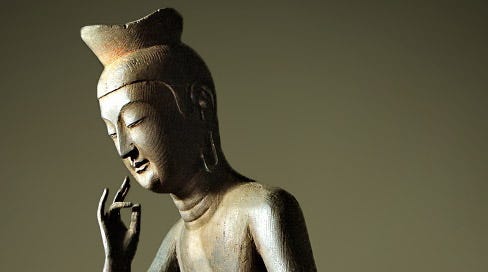Today, there are many opportunities to practice meditation.
It appears as part of yoga courses, self-development programs, and Mindfulness-Based Interventions, to name some of the most widespread examples. In this Substack, we will focus mainly on Vipassana (insight) meditation, which originates from classical Buddhism. Like Newton, the Buddha could have said that he was standing on the shoulders of giants: the Yoga tradition, with its deep cultivation of concentration, can lead to levels of this mental skill far beyond ordinary experience. The self-development courses mentioned above capitalize on the positive effects of meditation and related practices. Mindfulness-Based Interventions—specifically Mindfulness-Based Stress Reduction and Mindfulness-Based Cognitive Therapy—were developed for medical applications: to improve physical health and reduce the risk of relapse into major depressive disorder.
Initial Motivations
Meditation is said to increase happiness and decrease suffering. Sometimes in life we find our sincere efforts hindered by mental obstacles. In such cases, meditation can be instrumental in letting go of these sabotaging tendencies, helping us to live more authentically. Similarly, the stresses of daily life, past and present, may weigh heavily upon us. Meditation usually does not remove the external stressors, but it enables us to engage with them more lightly. Some care is needed, however, so that the resulting relief does not tempt us into taking on additional burdens, leaving us with the same—or even greater—distress. Meditation can also help us make wiser decisions, setting us on a less stressful and more satisfying path through life. The time needed to practice so that one may experience these results varies individually.
The Buddhadhamma recognizes these motivations but advises, in eloquent terms, not to believe such claims on faith alone—rather, to try them out and see for ourselves:
Now, Kalamas, don't go by reports, by legends, by traditions, by scripture, by conjecture, by logic, by analogies, by consensus, by probability, or by the thought 'This contemplative is our teacher.' When you know for yourselves that, 'These qualities are skillful; these qualities are blameless; these qualities are praised by the wise; these qualities, when adopted and carried out, lead to welfare and to happiness'—then you should enter and remain in them.
Instruction to the Kalamas, Anguttara Nikaya 65 (After Thanissaro Bhikkhu)
This is a clear expression of the scientific spirit.
The motivation to actually start and continue meditation varies. Often, one only undertakes it when the discomfort of one’s situation outweighs the effort required to practice. Yet sometimes, meditation brings the practitioner serene states of inner happiness, the so-called jhanas. Experiencing these can also be a genuine motivation to practice seriously. Another reason can be simple curiosity—traditionally called "the basis of success." Finally, some may find encouragement in the warm atmosphere of the meditation center, among fellow practitioners and teachers.
Ultimate Motivations
Those whose lives are running reasonably well may not feel an urgent need to meditate. Indeed, despite life's transiency, it is possible to find a satisfactory existence, to ‘love and work’. Yet even when everything appears to be in order, one may sense that something essential is missing—without being able to say what it is. The French poet Baudelaire used the English word spleen to describe this kind of unsatisfactory feeling: a longing for something undefined.
By bourgeois standards, Baudelaire’s life was far from orderly. It was filled with forbidden pleasures: wine, opium, and many mistresses. His pursuit of pleasure became an obsession. In Les Fleurs du Mal (Flowers of Evil), he captures his sensual lifestyle in the poem L'Invitation au Voyage:
Là, tout n'est qu'ordre et beauté, Luxe, calme et volupté. [There, restraint and order bless, Luxury and voluptuousness. Translation: Edna St. Vincent Millay.]
These lines have been memorized by French high school students for over a century and were masterfully set to music by Henri Duparc. Yet Baudelaire remained tormented by spleen, as seen in the title of one of his works: Le Spleen de Paris. For those unable to transform spleen into art, meditation offers an alternative—also leading to profound experiences similar to those Baudelaire described, but reached by different means.
Beneath the existential boredom called spleen lies a mind-state recognized in psychiatry and clinical psychology. The French psychiatrist Jacques Lacan termed it ‘Lack’ (Manque): a fundamental sense that something is missing. The English psychiatrist Donald Winnicott described it as the ‘Fear of breakdown’ (and added "But it has already happened and keeps happening"). Dutch clinical psychologist Johan Barendregt (my father) referred to it simply as ‘It’—what patients with phobia called ‘the unspeakable’, linked to the feeling of depersonalization. In what follows, we will explore these concepts further, and understand why Vipassana meditation can help to relinquish the deep existential anxiety they represent. In the Buddhadhamma they correspond to the first encounter of anatta (non-self).
Earlier, we distinguished between ‘initial’ and ‘ultimate’ motivations for meditation. These correspond to the initial and ultimate paths. The initial path seeks liberation from worldly distress—the desires for and aversions to things or situations in the external world or in memory. The ultimate path aims at liberation from existential distress—experiences of spleen, lack, It, and also fear of death. The work required for the second liberation is longer and more demanding, but it is also deeper and more rewarding.
The two kinds of distress are closely related: existential distress lies at the root of worldly distress. But existential liberation is lasting, whereas worldly relief, by itself, is not. It is important to know that work on worldly liberation is a necessary foundation for the second phase. Also encouraging to know is that not all worldly desires and fears must be abandoned at the beginning of the ultimate path; they will fall away naturally in the course of deeper practice.
The Buddha expressed the promise of this ultimate path as follows:
As the ocean is pervaded by one taste,
namely that of salt,
so this teaching and practice is pervaded by one taste,
that of freedom.
—The Buddha (Udana, 45: Uposatha)
Next Post Table of contents



